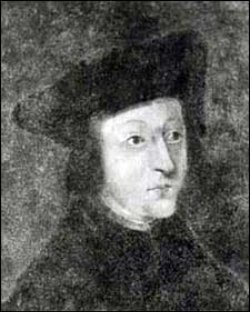
Eustace Chapuys
Born: c. 1490
Annecy, France
Died: January 21, 1556 (Age c. 66)
Chapuys in History
There is not a large amount of information known about the early years of Eustace Chapuys, including his exact date of birth, but sources tell us that he was born into a family with members of the gentry and the minor nobility. He began his education at Turin University in late 1507, where he was to receive his doctorate in civil and canon law by 1515. Seemingly, Chapuys was a prodigy of sorts considering that, by around 1517, while still a teenager, he was taking part in important ecclesiastic and diplomatic activities within Geneva and various parts of France. Chapuys continued to hone his diplomatic skills and, as a result, became a leading councilor to Holy Roman Emperor Charles V in 1527. It was the next task that Chapuys was assigned to that he would become most remembered for. At this point in time, King Henry VIII of England desperately wanted an annulment from his wife, Catherine of Aragon, aunt of Charles V, who had produced no male heirs and was impeding Henry's goal of marrying Anne Boleyn, whom he had fallen in love with. Chapuys was sent to England to act as an adviser to Catherine. The situation was certainly a delicate one because Pope Clement VII was reluctant to allow the annulment, because of pressure from Charles V, yet Chapuys did not want to risk angering Henry VIII and forcing him to use France as an ally against the Roman Empire. Though Chapuys, as a loyal Catholic, was on Catherine's side and against England breaking off from Rome, it was his goal to keep his opinions quiet. He did, however, protest the appointment of Thomas Cranmer as the new Archbishop of Canterbury, a move that sped up the annulment process and the break from Rome, considering Cranmer's reformist religious views.
Nevertheless, Henry VIII and Anne were secretly married in early 1533, Catherine was sent off to live quietly away from the court and her only child, Princess Mary, was declared illegitimate, being that the marriage between her parents had never been legal. Chapuys now took on a different role in advising both Catherine and Mary, as he instigated them not to quit fighting the issue. Though he was not allowed admittance to either lady, through his agents, Chapuys was able to keep them informed as to what Charles V's thoughts were on the matter and convinced Mary to sign the Act of Succession which stated that Henry's marriage to Anne was legitimate, most likely saving her life in the process. Oddly enough, Chapuys struck somewhat of a friendship with Thomas Cromwell, an avid reformist, at this point. Chapuys was finally permitted to see Catherine as she lay dying and was suspicious that her death may have been caused by poison, under orders from Queen Anne. All throughout this period, Chapuys continuously involved himself in English politics, stirring up trouble by exposing the people's dissatisfaction with their country's break from Rome and attempting to reinstate Mary to the succession. He attained a victory, when several months after Catherine's death (1536), Queen Anne was executed for treason, bettering Mary's chances for succeeding to the throne. Still later in that same year, it was rumored that Chapuys played a role in instigating the Pilgrimage of Grace, a rebellion of the northern commons over the ravaging of their abbeys and monasteries. The ambassador's involvement was based on his close relations with several of the leaders involved in the rising, including Lord Darcy. Chapuys was implicated in the rising, but nothing ever came of the accusations, and the rising itself was ruthlessly put down.
With both Catherine and Anne dead and the divorce debacle in the past, Chapuys was free to concentrate more on diplomacy outside England. He acted as a mediator between Henry VIII, Francis I of France and Charles V, all of whom were either vying for an alliance with one another or hoping for war with one another, throughout the entirety of their respective reigns. Francis and Charles were at war in the late 1530s, and again by 1543. At this point, it was agreed that both Henry and Charles would invade France. The following year, this happened, with Chapuys present with the English king at the invasion. All in all, the war proved to be a useless and wasteful event for all who participated, and Chapuys helped with a treaty to bring peace between the three leaders. By this time Chapuys was slowly retiring. He was plagued by gout for the last twenty or so years of his life, and travel was undoubtedly a painful and time consuming experience for him. A new Roman ambassador, Van der Delft, was sent to England to take his place, and Chapuys brought him up to speed on English politics and advised him on occasion. By the time Henry VIII died in early 1547, Chapuys was completely out of the English political loop. The former ambassador retired quietly to Louvain where he dedicated the remainder of life to planning the construction of a grammar school and a college. He died in January 1556 as a man in his mid-sixties. Chapuys dedicated his life to diplomacy but will most be remembered for his avid support of the beloved Queen Catherine against her hurtful dismissal from her husband's presence.
Chapuys in Shakespeare
Appears in: Henry VIII
Chapuys (as the character Capuchius) appears briefly in Henry VIII when he is seen visiting Catherine at her deathbed. He promises to deliver a letter from the former queen to the king, urging him to take care of their daughter, Princess Mary.
References
Davies, C. S. L. ‘Chapuys, Eustache (1490x92?–1556)’, Oxford Dictionary of National Biography, Oxford University Press, Sept 2004; online edn, May 2008 [http://www.oxforddnb.com/view/article/70785, accessed 13 May 2010]